Be the Lord or Lady of Your Own Lavish Castle With This Tudor Revival Fixer-Upper in Tuxedo Park
Do you envision yourself gliding dramatically through grand, lushly ornamented spaces as you host parties worthy of the style of Gilded Age?

Do you envision yourself gliding dramatically through grand, lushly ornamented spaces as you host parties worthy of the style of Gilded Age?
If you are also willing to put a bit of restoration time and money into the effort, Paxhurst in Tuxedo Park might contain enough original detail and space to entice. The early 20th century manse at 116 Tower Hill Road in Tuxedo Park, N.Y. is on the market for the first time in decades.
The Tudor Revival “cottage” known as Paxhurst was constructed in 1904 for William Mitchell Vail Hoffman and Irene Stoddard Hoffman. A real estate mogul in New York City, Hoffman was a partner in the firm Hoffman Brothers with his brother C. F. Hoffman, Jr.

William and Irene’s main base was their Manhattan home at 35 West 51st Street (since demolished). The couple, married in 1887, moved into the brick and limestone townhouse around 1899, after the house was altered for them by architects Barney & Chapman. Living in the lavishly furnished home by 1900 were the couple, their three young sons and five servants. By 1915, the New York State census shows the staff had grown to include two butlers, a cook, governess, laundress and five additional servants.
The Manhattan-based architectural firm behind the house, known in the late 19th and early 20th century for their churches, commercial buildings and townhouses, is also credited by many secondary sources as the designer behind Paxhurst. The connection is a likely one. In addition to the work Barney & Chapman did on Hoffman’s townhouse, they also did some work on Hoffman’s investment properties.

The house John Stewart Barney and Henry Otis Chapman likely designed for the couple in Tuxedo Park was a picturesque departure from the sedate facade of the Hoffman’s city townhouse. The Tudor Revival country manse is perched on a hill with a dramatic rubble stone tower surrounded by half-timbered wings.
The house, and the wealthy and social couple, fit into the lifestyle of their country neighborhood. A planned community for the wealthy, Tuxedo Park was developed in the 1880s as a country playground for the Gilded Age, with massive “cottages” nestled into the foot of the Ramapo Mountains.

Using family land and his tobacco fortune, Pierre Lorillard IV, along with his architect Bruce Price, began plotting out the vision for a sporting club and exclusive residential community in 1885. The town would become a second home for New York City’s wealthy, who moved into homes designed by Price or other noted architects such as McKim, Mead & White, Heins & LaFarge and Delano & Aldrich. In the pre-World War I heyday of the community, the elite golfed, sailed, ice skated and held parties at the community clubhouse.
The Hoffmans, who appear from newspaper accounts to have spent earlier years at other cottages in Tuxedo Park, were able to launch into the social scene from their very own home in the fall of 1904. The origin of the Paxhurst moniker is unclear, but its meaning, roughly that of a peaceful wooded hill, is certainly appropriate. The house is referred to as Paxhurst in newspaper accounts as early as 1906.


By 1907, Irene was already in the midst of giving the house a spruce-up in preparation for what the New York Press predicted would be a season of “lavish entertainment.” Many of Tuxedo Park’s most prominent hostesses were redecorating and while the full details of the Hoffman’s changes weren’t described, the paper noted that all the sprucing up of houses before the season was sure to “make the name cottage as applied to a residence in the park more of a joke than ever.”
Paxhurst stayed in the family’s hands until roughly the late 1950s. William died in 1947 and Irene ten years later.

One of the later owners of Paxhurst was an old house lover. The late John Foreman, the author behind the Big Old Houses blog, owned the house from 1977 to 1980. In posts about the house, he described it as “the most beautiful house in which I ever lived.” He and his wife purchased the place for $175,000 but, he confessed, “we were spectacularly unable to hold on to it.” His posts about the property are worth a read, both for the historic images he included as well as the comments from former residents, neighbors and fans of the property.
The house has been in the hands of the same family for the last 35 years, according to the listing, and is ready for another passionate old house lover to lavish some attention on its grand spaces. The listing includes a few photos but if you want a grand tour, including a nifty feature where you can go through the floor plan and click on images of almost every room, head to the virtual tour at Jump Visual Tours.

As expected from the dramatic exterior, the interior does not disappoint. Particularly the grand spaces of the first floor, practically a requirement for keeping up with the entertaining expected of the original Tuxedo Park residents. The Tudor Revival style of the exterior continues into the entrance hall, which looks like it is just missing some armor to really burnish the faux-medieval theme. Alas, as will be noticed in other views, there are some ceiling issues but remarkably the original woodwork, mantels and other historic details are intact.
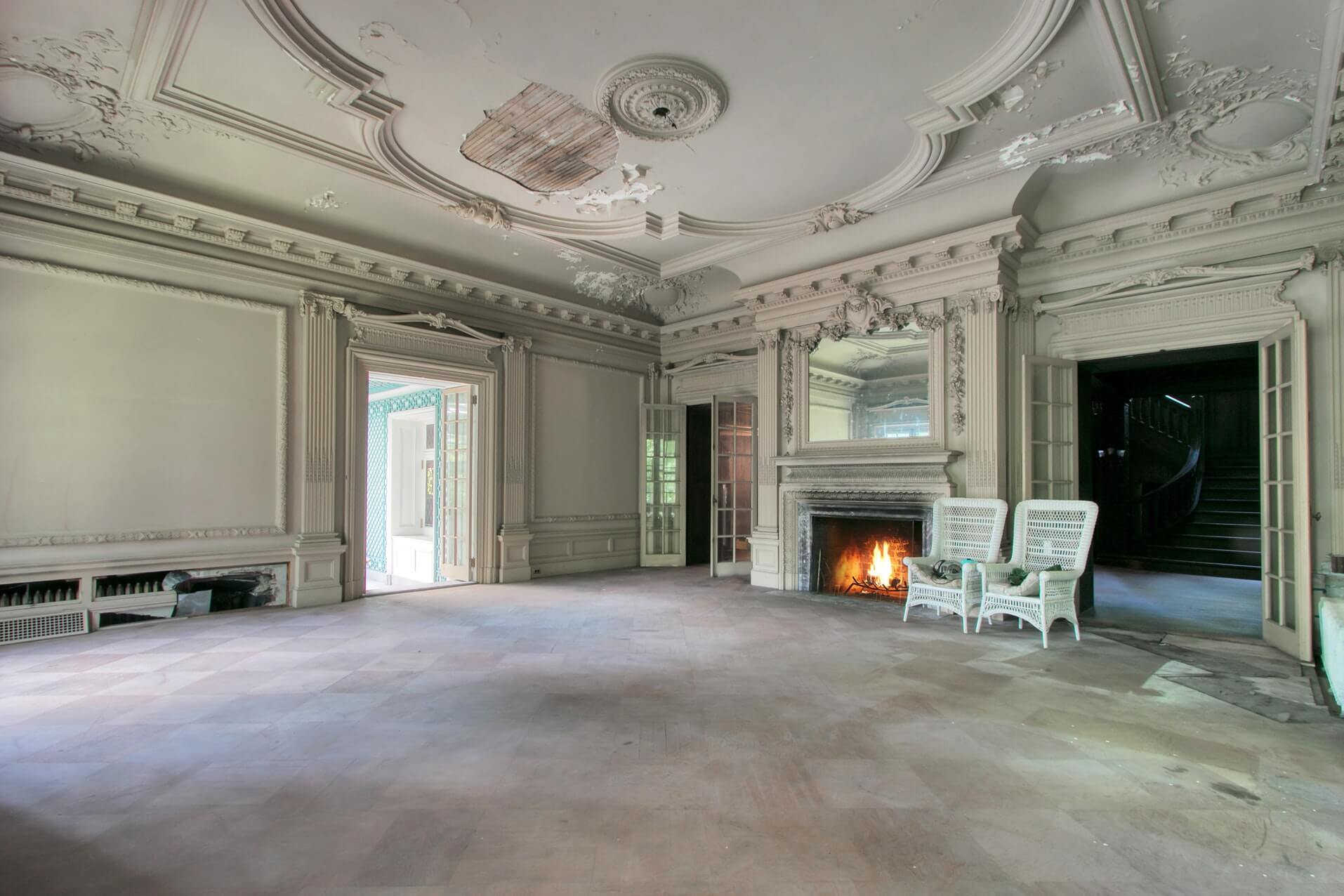
The first floor includes multiple spaces designed for socializing, including a grand ballroom with elaborate moldings, plaster ceilings and dramatic mirrored overmantel. For truly large bashes, the french doors to the adjoining rooms could be thrown open for French doors between the ballroom and adjoining spaces.

A stunning strapwork plaster ceiling appears to be intact in what was most likely the main parlor or gathering space. There’s another mantel and plenty of original woodwork.

Connecting the ballroom and the parlor is a latticed solarium, with views to the wooded landscape and plenty of room for a potted plant paradise.

What is described as a great room is possibly the original dining room, tucked close to the servant’s staircase. The room is somewhat more intimately scaled and has a more classic flair, with a columned mantel and what appears to be egg and dart molding.

Just off the dining room is a verandah, with more latticework and views to the great outdoors. There are also French doors out to the patio.

On the opposite side of the first floor another parlor, like the dining room a bit smaller in scale and with delicate plasterwork.

A wainscotted study is the final social space on the first floor. There’s a Tudor arched mantel that appears to be in good shape, but it’s tough to tell what original ceiling details may have been lost.

A small kitchen is located off the dining room, possibly once a butler’s pantry or other servant space. There’s a service door to the outside and it’s around the corner from the secondary staircase.
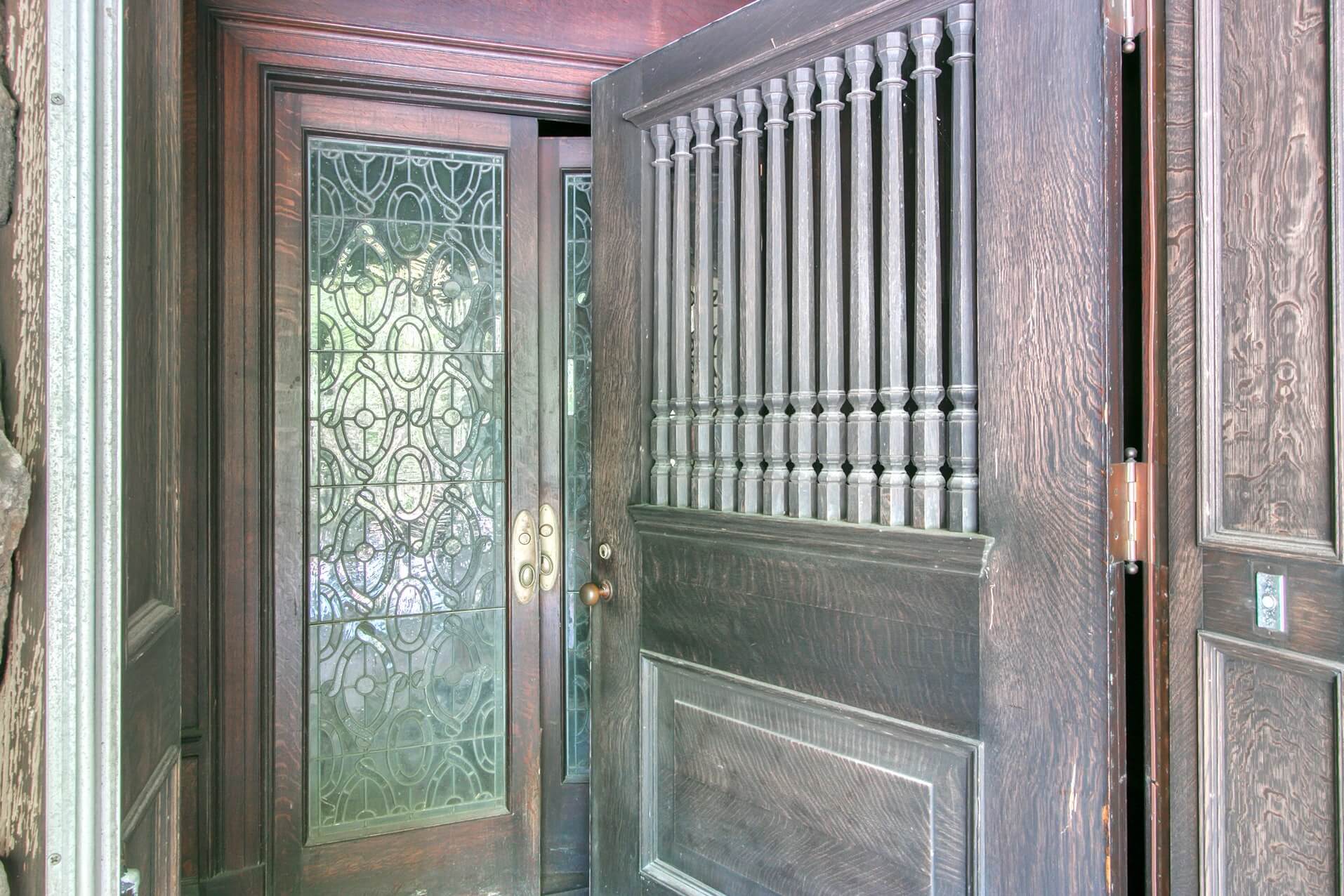
For guests staying over, the elevator to the bedrooms above is conveniently located off the main hall.

The listing indicates seven bedrooms, but the included floorplans have 15 rooms indicated as bedrooms. Six of these, and the grandest of the lot, are located on the second floor, some with fireplaces, dressing areas and en suite bathrooms.

The bedrooms on the third floor were likely for servants, or perhaps less favored house guests. Some of the nine bedrooms on this floor include sinks in the rooms, with everyone sharing the two full baths on the floor.

There’s a half bath located on the first floor and seven full baths on the upper floors. Some of these have fabulous vintage fixtures, including original sinks, clawfoot tubs and high tank toilets.

There aren’t any photos or a floorplan of the lower level included in the listing, but presumably, there is plenty of room to carve out a wine cellar.
The house is set on just over 2.5 acres. With the wooded, hilly location the house is somewhat sheltered from near-by neighbors. Exterior views show dramatic stone patios and pathways through the woods.
For quick trips back to the city the house is just under two miles from the Tuxedo Station with MetroNorth service.
The house is listed for $975,000 by Walter Deane of Tuxedo Park Fine Homes.

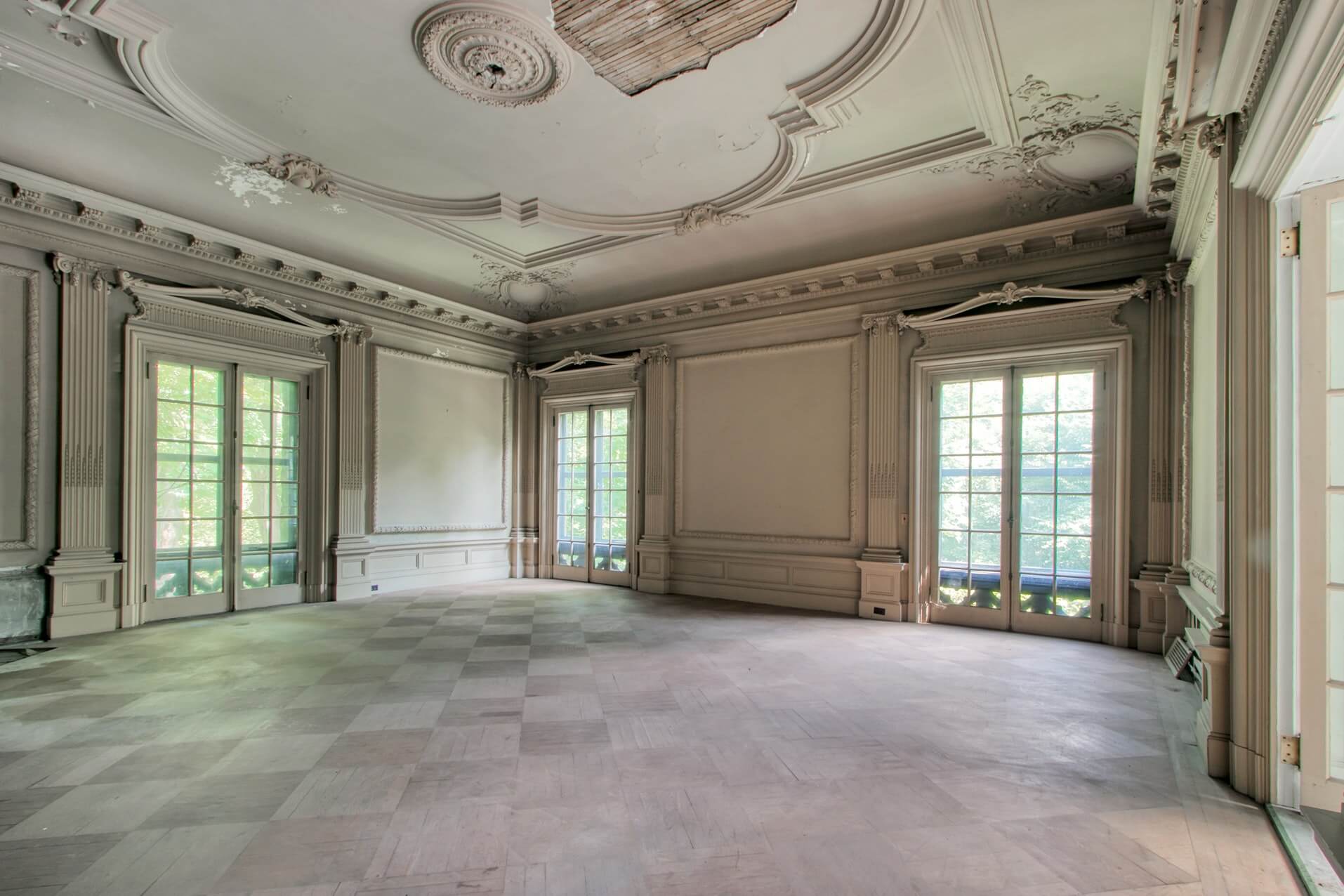



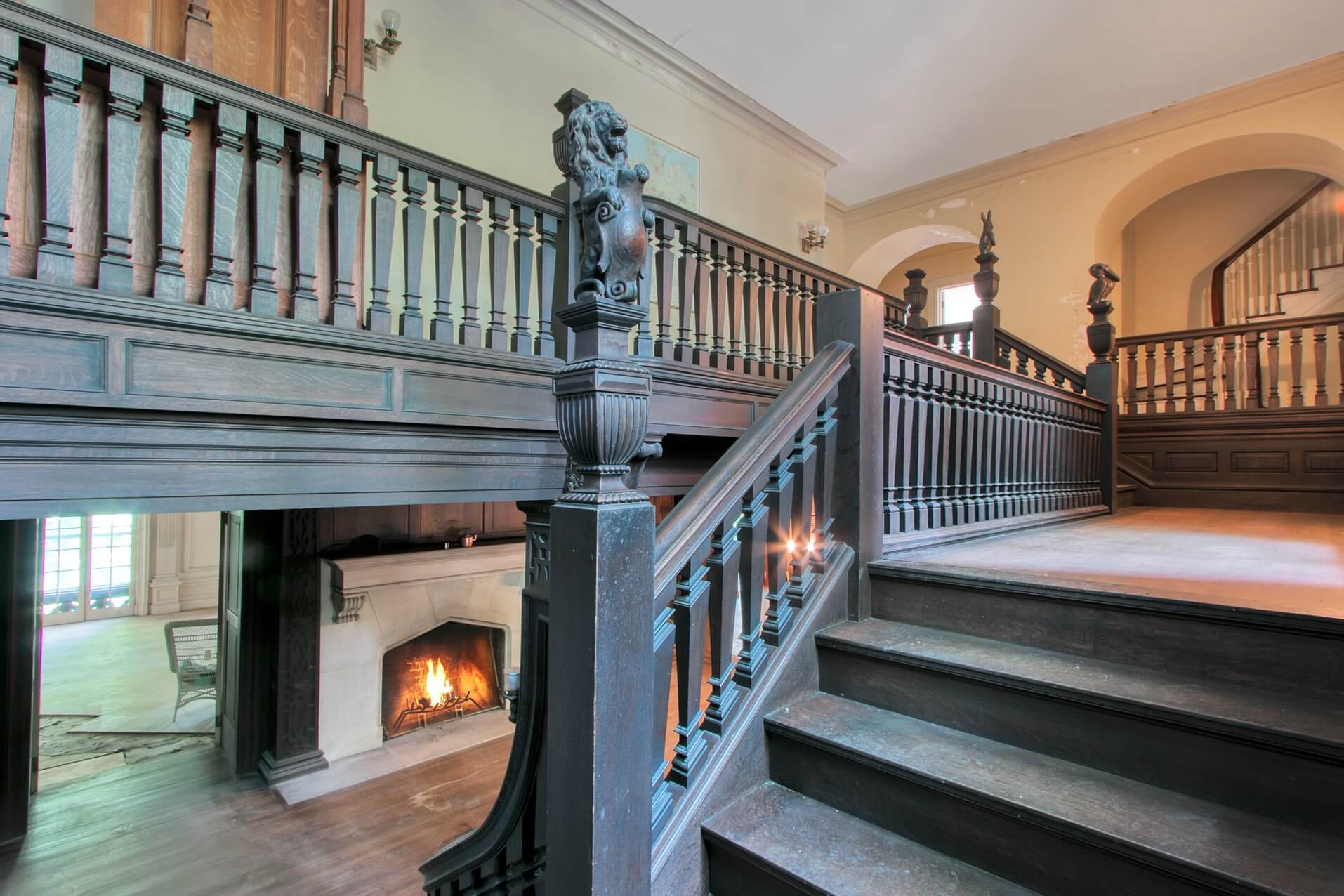






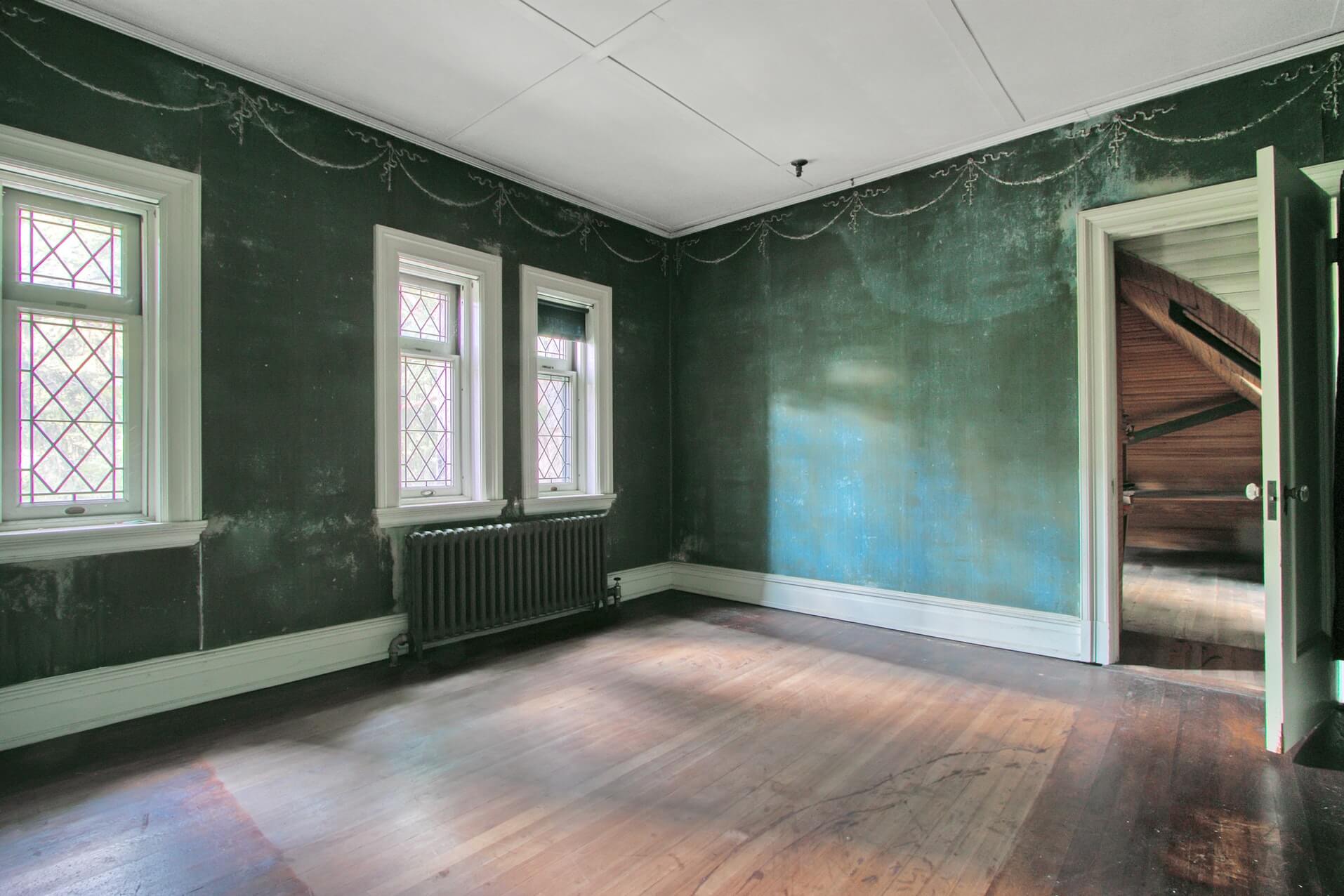







[Photos via Tuxedo Park Homes and JumpVisual Tours for Tuxedo Park Homes]
[h/t: Old House Dreams]
Related Stories
A Picturesque Stone House in the Land of the Headless Horseman Asks $995K
Email tips@brownstoner.com with further comments, questions or tips. Follow Brownstoner on Twitter and Instagram, and like us on Facebook.





What's Your Take? Leave a Comment